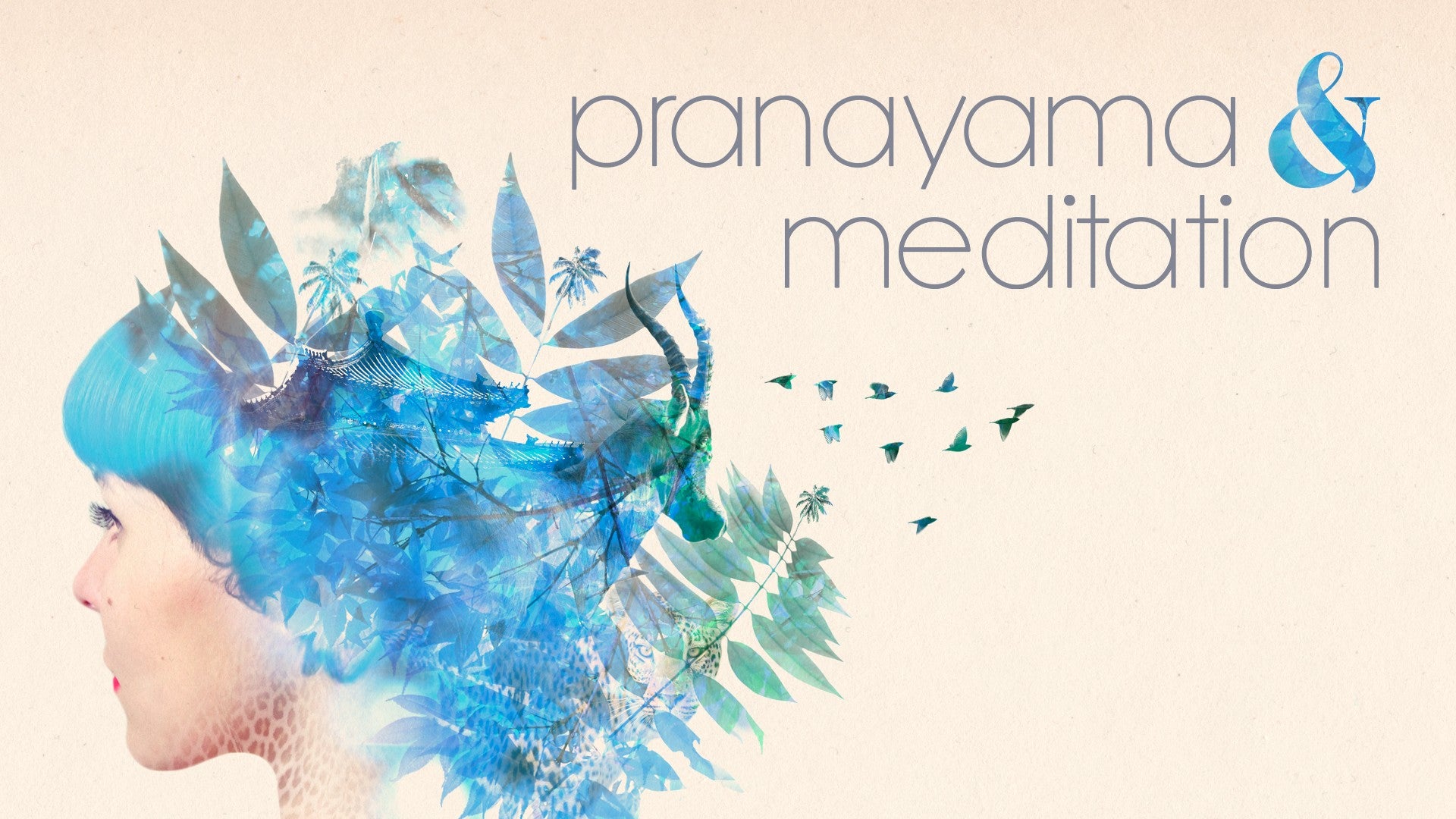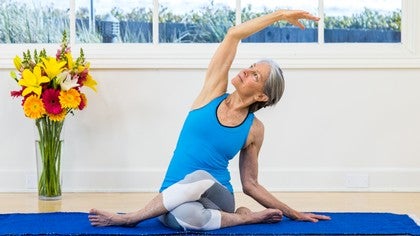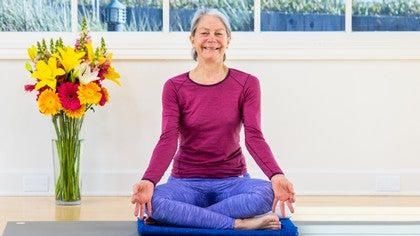Description
About This Video
Transcript
Read Full Transcript
Hi, everybody. In this practice, we're going to be working with bringing our awareness to one side of the torso at a time, and the setup that we'll be doing will help us to feel inside our structure one side at a time, and we can learn a lot by doing that. Our first posture is going to be a lead-up to that, and it's a half-dog pose. So I'll have my two friends here, Citrine and Rosemary, come onto their hands and knees, and pushing back with the hands so that the hips go behind the knees, but not too much, and then walk the hands forward, bring your forehead down, and let's have both of you with the arms straight at first. Push your hips back a little more, Citrine. Also, you, Rosemary, a little bit more, so that you start to feel like your hips are a counterweight. I would say go back further with your hips, so walk your hands back further this way, that way. There you go. That's it. There. And then you can almost just relax, and if you pretend that you're gluing your hands to the mat, the weight of the hips pulling you back gives you some traction in your spine. And you might want to counter with just a little bit of drawing the arm bone towards the socket. That's it. Okay, and allow yourself to do that for one more breath. And now, as you inhale, lift your head and shoulders, and walk both arms over towards your right a little bit. Just enough to give yourself, might be a lot, you might need to go a lot, but to give yourself a sense of being, of stretching on the left side of your ribcage, especially as you breathe in, feel that left side receiving most of your breath, which means it's going to be getting more juice from the pranic inflow as well. And sometimes this can be enhanced by swinging your feet around a little bit, so you lift them slightly and swing them around to the left. Right. Swing them to the right. That's it. When you swing them to the right, you should feel that that increases the side stretch on the left. Breathe into that a couple of more times. That's it. So we're opening the structure first to make room for the subtle awareness to come in a few moments. Inhale and lift your head and shoulders, walk around so that you're bringing your arms over to your left side, which allows you now to stretch the right. Yes. And if you feel like you want a little more stretch on the right side, swing your feet around to the left. That's it. If it makes the stretch so intense that you can't really penetrate your breathing into that area, maybe that's a little too enthusiastic. So you decide what feels right for you. You want to be comfortable in that right shoulder so that it's not getting dragged out of the socket. Sometimes a little pull back of the arm bone into the socket is helpful. Okay. On your next inhalation here, you're going to lift your head and shoulders and walk your hands back to the center. And I'm going to give you two variations that you can work with. One is to go back all the way into a child's pose. Not quite child's pose. The hips. So I'll have Satrine do this first. You go back. Not quite fully into child's pose. Forehead down on the floor and then let your elbows bend. They can move out to the side. Do bring the forehead down and just sink in. Maybe bring the hands a little higher over your head. So it should be comfy and allowing you to relax. The Satrine is a little more active. Rosemary is going to stretch her hips back a little ways too but also walk her hands out. And she's going to do something we call cupping of the fingers. And it arches the wrists and palms up and hopefully the elbows as well. Head may or may not come to the floor. It activates the shoulder blades and allows them to move towards each other. And if you're feeling a little dull, it's a, as I say, a little bit more activating and asking a little more of you so that that can help you when we turn around to relax in just a moment. So a few more breaths here. Feel the breath come into your belly or wherever it is allowed to come. Okay. And then on your next inhalation, lift your head and shoulders. Your hands can go flat again. That's it. And we're going to get ready to set up two variations of reclining bound angle pose again for this next one where we'll be experimenting with getting our awareness into just one side of the body. I think we'll set up Satrine first with, you're going to have one block like so and one like so. That'll need to go back a little further because the bolster is going to be resting on it like that. Yeah. So you'll want to be able to stretch out your legs eventually. Okay. Yeah. And you'll put your pelvis down just in front of the bolster. You can always use a, if you have a good firm couch pillow you can use the couch pillow instead of a bolster. We're going to take the blanket and roll it this time. We want, we don't want it too thick and heavy so we're opening it wide and we want this to support over the feet and around underneath the tops of the thighs. So try it so that it comes under here. Down and around like that. Yeah. Do you feel how that supports your thighs? Okay. And then lie back on the bolster. Oh, excellent. That's good. All right. And then we're going to do the other set up in the fashion. We're going to take your head this way. Two long narrow folded blankets. So it comes up to about three and a half inches height and it's going to be the bound angle position once again with the legs supported by two foam blocks. And if you have a ponytail it's often a good idea to take it out when you lay your head back on something. Sometimes you can just pull the band back a little bit, but it can definitely impede the release of the skull, the skin of the scalp. It's a very sensitive area. Okay. Very good. With this set up I do want you to be able to get a little bit of that movement of the chin down. It's just so calming to the whole system. So I'm going to put one blanket under Citrine and Rosemary can fold hers under. So you want to give yourself that release of the face being able to pour its energy down towards the heart, pacify the thinking mind to allow the heart mind to be a little more open. Okay. And if it feels like there's too much pressure from that blanket under your neck you can always push the blanket backward and you want to feel that that impetus of the forehead coming down is a continuous flow. And now I'm going to ask each of you to place your dominant, leave your dominant arm open out. So that may be right. It may be left and take your non-dominant hand and turn it down and place it right around where your thigh joins your hips and your pelvis. So that side is going to be a little more closed than the other side. And the side that's closed you're going to like put your awareness not to sleep there, but you're going to let your awareness like flow over like a wave or like watercolor spreads in a nice wet watercolor paper and it just really bleeds out into the whole area. So you're going to let your awareness flow over to the open palm side and breathing in and breathing out. Notice how that side receives the breath. First structure, how the belly, how the ribs, how the upper chest receives the breath and releases it.
And I like to keep the sense of breathing in and down to fill up and releasing from the body, at the bottom of your body, the belly before releasing the chest. It's not like the other side won't be receiving the breath, but your awareness is very much on the open side. And let your awareness penetrate inside as well. Perhaps you could imagine feeling the breath coming into after it passes through the nostrils and down into the throat area and into the lungs. Perhaps you can feel that. You can feel the organs expanding on the in breath and everything letting go of the out breath. So from the inside what do you feel? And you're not really trying to control the flow of the breath, you're just observing what it feels like to have that side more open than the other. How does it receive? How does it let go? And that it, of course, is you. Now you could do a whole shavasana like this for a long period of time. Or I would say havesies, half on the other side. That's, I think, enough to get a sense of it for this side. As you come to the end of this next in breath, as you're exhaling, let your open palm come up and rest on the thigh right where it joins the pelvis. Feel everything becoming more symmetrical. And then as you open the non-dominant side, which for these two is the left, what is it for you? Opening it out. And it may take a few moments, a couple of breaths maybe, but now you're encouraging your awareness to flow over to this other side. So we might think that the dominant side won't want to let go of the awareness and let go of the sensation of the breath, but it will. Just let your interest, your curiosity come to this left or less dominant side for you. Again, structure first, and then gradually moving inward, including nostril, lung. Now one side is said to be more outwardly flowing, our awareness. The other side more inwardly, more receptive. Perhaps you feel some sense of that as well. Just receiving the breath, letting it go, all on that one side, awareness fully awake to perhaps some areas that it isn't usually awake to. And now you're going to let your dominant side hand open out again so that both sides feel equally open with respect to where the arms are placed. It'll take maybe a little longer for the structure and the innards to feel symmetrical, but try to divide your awareness equally amongst both sides, which is basically letting your awareness be undivided. Undivided attention to feeling the sensations of the breath coming in, to the structure first, and then the inner sensations, eyes and brain softly falling down towards your heart. And really narrow your attention so that you feel the breath coming through your nostrils and down more. Just imagine your awareness being very close to the inner spine area and flowing down and up along the spinal area to left and right. It might be pure imagination. There might be some sensation to this. It might be more visual for you. You might feel that both sides are receiving and releasing evenly. You might not. Just what's true for you right now allows you to learn something. How close to the very center can you let your awareness flow with your breath, the very center axis. Other sensations may be present in the periphery, but your concentration is on this center. And now, having gotten perhaps a little taste of that lying down here, we're going to bring it into sitting. So in as non-disturbing away as you can, you're going to imagine and then move, rolling over to one side, using your hands to help your legs if you need to. Yes, if you're on the higher height, sometimes just sitting straight up is best. Come back. For our sitting posture, we're going to have two variations. Citrine is going to put a blanket under her hips and come into a half lotus position. So the blanket, you know, maybe you need a lot of height. You can certainly use it. You could even sit on the bolster.
And we're just placing the other props out of the way. Part of the reason for the height is to get a little bit of the forward front tilt of the pelvis, so the lumbar spine, this S curve that we've been blessed with as vertical beings. It's very important for the sitting posture standing. We're also going to show you something that is an ancient traditional style of meditation. And I saw this in the Asian Art Museum a few years ago when they did a show on yoga and it was in a very ancient statue of the lion-headed version of Vishnu who is considered to be the preserver deity in Hinduism. And Vishnu, as you'll see it unfold with Rosemary here, was sitting with a belt around the lower ribs, lower to mid ribs, and around the knees. I think it could be a little wider, but was I going to put you on height? I'm not sure. We'll see. Yes. And then the knees act as a little shelf for the arms. She's adjusting. You have to kind of play with it. You might need something under your hips to make this work. It should be that your legs support your back and your back supports your legs because of the binding of the belt. And it's said that these meditators would stay in this posture for really long periods of time. They could even sleep there. All right. So now that we have our upright posture settled, what I would like you to try doing is to, once again, just for maybe two breaths, bring your awareness in and out, and in on your dominant side. Feel the breath flow in. Feel it flow out a couple of times. And notice how you're doing as you're doing this. If your eyes don't instantly want to close, you can have your eyes open and a little downturned, but they may recede even if they're open. That's beautiful. After the next inhalation, once you feel full-ish, 85 or 90%, let your awareness go over to your non-dominant side and take two or three breaths. Allow the breath to move in and out with your awareness concentrated on that side, outside and in. Inner senses are opening. And then please, for just a few cycles, see if you can, once again, divide your awareness equally between right and left sides of nostrils, rib cage, belly, lungs. This dividing of awareness is a giving of awareness equally, which ends up being undivided. And over the cycles of breath, awareness coming closer and closer to the center. You might even notice perhaps that the breath flowing into and out of the nostrils feels more and more equal. Lower it, please.
There's a turning point where your breath, instead of continuing to lengthen, begins to get quieter and even more shallow. And this is a sign that you are going deeper into the meditation. Because you're so still and quiet that the longer breaths are not needed. The prana is full, fully in you, neither leaving nor entering. If you're still in it, when you're in it, please find 120 gained and for this healthy Whatever your experience is now, it's perfect, it doesn't need improving.
Remove your experience, whatever it is, and holding that experience in your heart and in your body. Let go of the posture if you're ready to stretch out your legs, and don't hold on to this moment. Just let it go. This might be a great time for Shavasana, which I encourage you to do if that's what comes up for you, but we're going to just bow out. So palms together in front of your heart, drinking in this experience, and allowing, encouraging, intending the benefits of this practice to radiate outward towards all beings. Namaste.
Pranayama & Meditation: Patricia Sullivan
Comments
You need to be a subscriber to post a comment.
Please Log In or Create an Account to start your free trial.











